James Wilkinson was born in Calvert County, Maryland, probably in 1757. He studied under a private tutor and then took up medicine in Philadelphia. In the early days of the Revolution, he fought with Thompson’s Pennsylvania rifle battalion and then was commissioned a captain in the Continental Army. Wilkinson served in the siege of Boston and then with Benedict Arnold in Montreal. In early 1776, he was an aide to General Horatio Gates.
Wilkinson was brevetted brigadier general in November 1777 and served as the secretary to the Board of War. General Washington forced Wilkinson to resign both positions for his role in the Conway cabal against the commander-in-chief. He then served as clothier general of the Army until some minor scandals forced his resignation.
In 1782, he married Ann Biddle and joined the Pennsylvania militia as a brigadier general. He then moved to Kentucky and urged its separation from Virginia. Wilkinson returned to active duty in the U.S. Army as a lieutenant colonel in 1791. He rose to the rank of brigadier general and served under Brevet Major General Anthony Wayne at the battle of Fallen Timbers. From 15 December 1796 to 13 July 1798, he was the senior officer in the Army. In 1798, Wilkinson was sent to the southern frontier.
From 15 June 1800 until 27 January 1812, Wilkinson was again the senior Army officer. He took possession of the Louisiana Purchase in 1803, with Governor William C. C. Clairborne, and soon became the governor of the Territory. In 1810, he married his second wife, Celestine Laveau. In 1811, he faced a court-martial for various intrigues and scandals, but was cleared was cleared of any wrongdoing. During the War of 1812, he was a major general, but in 1813 he was relieved from duty for his failure in the Montreal campaign. Once again, a panel of inquiry cleared him of all wrongdoing. Wilkinson died in Mexico City, on 28 December 1825.



